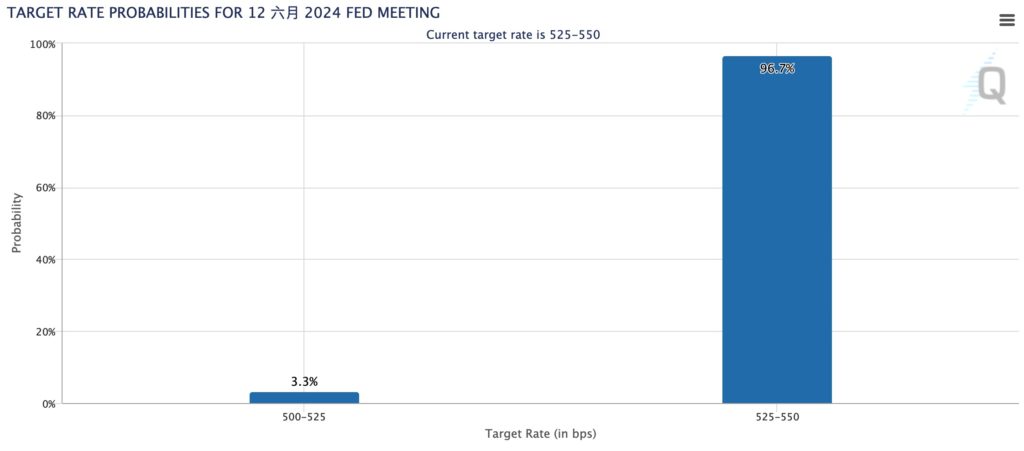The U.S. Federal Reserve (Fed) has frozen interest rate increases for the sixth time in a row this month, keeping the federal benchmark interest rate unchanged at a range of 5.25% to 5.5%. High inflation has poured cold water on expectations of interest rate cuts. .
Ball: Patiently waiting for high interest rate policy to ferment
Just yesterday (14th), Powell said at a conference in Amsterdam that the U.S. inflation rate in the first quarter did not develop as expected, so the Federal Reserve needs to remain patient and wait for more evidence that high interest rates are developing. Suppressing inflation implies that the Fed may or may not implement interest rate cuts in the short term.
At the same time, Powell also reiterated during the meeting that the next step for the Fed is unlikely to be to raise interest rates.
The Fed doesn't believe fighting inflation is a smooth path, but recent data are higher than anyone expected; we need to be patient and let restrictive policies take effect.
In addition, the latest Producer Price Index (PPI) data released by the U.S. Bureau of Labor Statistics yesterday (14th) showed that the PPI increased by 2.2% year-on-year in April. Although it was in line with market expectations, it still hit a new high since April 2023; and on a monthly basis Looking at growth of 0.5%, higher than the revised -0.1% in March and higher than market expectations of 0.3%, Ball expressed "mixed feelings" about this.
PPI is usually regarded as a leading indicator of inflation. It is also closely watched by the market as the Consumer Price Index (CPI) for April, which is expected to be released tonight (15th) evening. The dynamic zone reminds that there may be fluctuations.
On the other hand, according to Bloomberg, Kansas City Federal Reserve President Jeffrey Schmid said yesterday (14th) that the current inflation rate is still too high and the Fed needs to prepare more work to reduce the inflation rate. Therefore, interest rates are likely to remain high for some time, and the era of low interest rates may not return.
I’m not sure we’ll ever return to the low interest rate environment of the decade before the pandemic.
Interest rate expectations for the second half of the year
According to CME Fedwatch interest rate futures market data, the market estimates that the Fed has only a 3.3% chance of cutting interest rates by 1% in June, and the rate of continuing to remain on hold is 96.7%. The chance of a rate cut in July is about 25%, and the chance in September is about 50%.
Clark Bellin, chief investment officer of investment management company Bellwether Wealth, said after the April PPI data was released: "The unexpectedly hot inflation data has raised the possibility that the Fed may only cut interest rates once this year, which may be at the end of the year."

Inflation data determines rate hikes and cuts
Wall Street Journal reporter Nick Timiraos, known as the "Fed's mouthpiece," has previously written that a series of disappointing price and wage data have caused investors to pay less attention to the Fed's outlook and instead focus more on the economy. Data, Neil Dutta, director of economic research at Renaissance Macro Research, said:
Ball can say whatever he wants, but ultimately the inflation numbers will determine what happens.
At the same time, William English, a former senior adviser to the Federal Reserve, believes that even if Ball stated that it is unlikely to raise interest rates, he did not rule out this possibility. In the end, the Federal Reserve will still make decisions based on inflation data:
In terms of peak rates, I think... the data will answer that for us.
There are two schools of thought within the Fed
In addition, Nick Timiraos mentioned in the article that there are currently two factions of views within the Federal Reserve. One faction is worried that keeping interest rates at too high a level for too long while inflation and wage growth are decelerating may pose a risk to regional banks, Commercial real estate investors and other industries are adding to the pressure.
Extended reading: Report》Nearly 300 banks in the United States are facing bankruptcy! High interest rates create bad debt crisis
Another school of thought believes that due to the strong economic performance, there is almost no need to cut interest rates this year. They are worried that when the Federal Reserve sets the inflation target at 2%, the inflation rate may stay at a level well above 2.5%. They are considering cutting interest rates. ahead, hoping for more evidence that the economy is slowing.




